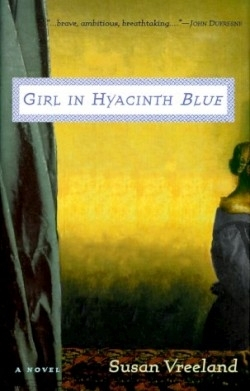Girl in Hyacinth Blue
“There was something in this girl he could never grasp, an inner life inscrutable to him. He was in awe of the child’s flights of fancy, her insatiable passion always to be running off somewhere. To still it for a moment, long enough to paint, for eternity, ah.” These were the thoughts of Vermeer, a Dutch painter suddenly captivated by the idea of using his young daughter, Magdalena, as a model. He noticed “her eyes, pale cerulean…[how the] open window reflected her face, and in one pane, the image of her cheek shone luminous as though blended with the dust of crushed pearls.”
The fictional portrait, the “Girl in Hyacinth Blue,” becomes the pearl that is not crushed as it is sold, stolen or tenderly given by one owner
to the next. Though described as a novel, Vreeland’s book is more a collection of short stories. Rather ordinary people own the work beginning in the seventeenth century when it was given by Vermeer’s family to a baker to pay off bills. “Love Enough” relates that its present owner, an American professor, has hidden the painting because it reminds him of the terrible truth about his father’s past.
The portrait has perhaps the most meaning for Vermeer’s daughter, who appears in the final poignant story, “Magdalena Looking.” In 1696, as a woman with bad teeth, she sees the painting at an auction and yearns to own it again. Magdalena recalls sitting for the portrait and remembers how she wondered then what she meant to her father. “Slowly, she came to understand that he looked at her with the same interest that he gave to the glass of milk.” Yet, the reader knows from “Still Life” that for Vermeer, the glass of milk in the scene made “the whole corner sacred with the tenderness of just living,” and at the moment of his inspiration, Magdalena stood before him “as if offered by God.” Vermeer enhanced his exquisite paintings with mundane objects; Vreeland places the girl’s portrait in the possession of ordinary people leading ordinary lives.
Vreeland is an accomplished author whose first novel, What Love Sees, was broadcast in 1996 as a CBS Sunday night movie special. She
teachers English literature, creative writing and art in the San Diego public schools.
The Girl in Hyacinth Blue should appeal to readers who enjoy non traditional love stories.
Reviewed by
Linda Salisbury
Disclosure: This article is not an endorsement, but a review. The publisher of this book provided free copies of the book to have their book reviewed by a professional reviewer. No fee was paid by the publisher for this review. Foreword Reviews only recommends books that we love. Foreword Magazine, Inc. is disclosing this in accordance with the Federal Trade Commission’s 16 CFR, Part 255.

